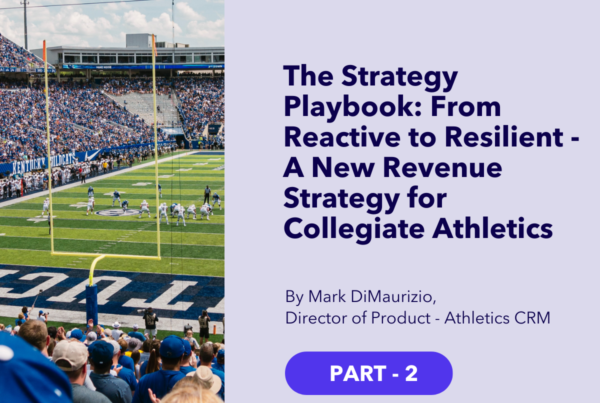In higher education and nonprofit advancement, resources are tight and need is high. Never has there been such an emphasis on efficiency and targeted strategies in fundraising.
So, how do we sort through thousands of records to identify and reach prospects and donors who want to hear from us and contribute to our initiatives and missions?
Advancement professionals are always searching for effective ways to define and measure the engagement of volunteers, alumni, and prospective donors. Engagement scores are one such tool.
What is Engagement Scoring?
When organizations create an engagement score, they select a certain set of variables (or fields) in their database and assign each variable a weighted point value in order to quantify the level of their constituents’ engagement with the organization. Engagement scores empower them to rank prospective donors, identify their biggest supporters, or compare different segments of prospects.
Perhaps most importantly, engagement scores allow the organization to take strategic action in how they identify, communicate, and engage with prospects. But engagement scores won’t be useful if the organization doesn’t have an idea of what it is trying to accomplish with them and why.
There are infinite ways to measure engagement on a spectrum of complexity, from assigning a simple point system to a few engagement activities to a strategy that may involve regression analysis or predictive modeling. To help provide industry standards, CASE released “a new Alumni Engagement Metrics (AEM) survey, enabling institutions to measure alumni engagement across four ‘modes:’ Philanthropic, Volunteer, Experiential, and Communications, with the goal of providing a simple way to capture various types of alumni engagement on an annual basis.”
One of the things we’ve learned in our work with universities and nonprofits is that engagement scoring can be challenging and hard to standardize because every institution and organization is so different—their culture, the needs and interests of their prospects, as well as how they gather, store, and use data.
That’s why we’ve taken a customized and project-based approach to engagement scoring. Here, I’ll walk you through our process briefly and demonstrate how it helps institutions take action!
What is ALUMinate’s Approach to Engagement Scoring?
We approach our relationships with our clients as project-based partnerships. We start by asking the following: what is useful for this specific organization, their unique prospects and alumni, and the data they have (and don’t have) in their database or CRM?
We also ask our clients: what does engagement look like for you? How does your organization define this? What do you want these engagement scores to help you achieve?
Through our SCORE’d data analytics service, we work with our clients to produce two different scores for their individual prospects (or other constituents):
- a wealth score
- an inclination score
For wealth as well as inclination scores, we have a default list of data fields (such as giving data, volunteer activity, and event participation) that is our starting point. Each data field can earn a certain number of points and carry a certain weight in the final score output. The wealth and inclination scores come together to make a composite score, but I’ll get to that momentarily.
How is ALUMinate’s Approach Different? What Does Customization Look Like?
As noted above, these default data fields are simply our starting point. What makes our approach different is that we then work with the client to look at:
- What data they’ve been tracking for engagement (such as events, volunteering, awards, meetings with development officers, etc.)
- How they’re tracking these things in their databases
- Any non-standard analytics or activities they’re been tracking that we could include in the wealth or inclination scores. As an example of a non-standard activity, we recently worked with a university that had data on which alumni had purchased a physical alumni directory book when it was recently offered
- Additional data they could start to collect that would provide useful insights, such as deploying a short survey to discover “interests”
Customization and flexibility are key here—which data fields/activities we look at, what scores they can each earn, and how they’re weighted within the overall wealth and inclination scores can all vary based on the client.
In addition, a number of these data fields have different tiers within them, where an activity could be ranked as a 3, 5, or 7, as opposed to a simple yes or no (1 or 0 score). This allows advancement practitioners to account for varying levels of engagement within one activity or program, and it helps them think about engagement in a more granular and sophisticated way.
For example, if an alumnus registers for an online Zoom webinar the institution is hosting but he doesn’t show up, that registration could earn the alumnus only 2 points, while registering and attending the Zoom webinar could earn a different alumnus a score of 5 points. For one event, you could track and weight who registered, who never registered, who was a no show, who attended the entire event, who took a follow up survey, their satisfaction with the event, and other meaningful input.
Instead of limiting a wealth or inclination score to a small number of fields, we utilize a diversity of data fields (inputs). If you don’t have certain data or have spotty data or prospects hide their data (this is especially true when it comes to wealth indicators), we can look for clues across a larger swath of data fields. It also is very useful to look at information, to the extent available, about the alumni’s activities while in school, such as participation in student government, Greek society, sports, clubs, scholarship awards, etc.
Discovering What is Meaningful Through Ranking
Another step in this process is accounting for varying levels of importance between engagement activities. Not all events and programs are equal. For example, an alumnus’s attendance at a football game obviously will not be given the same weight in an inclination score as a private dinner with the law school dean.
Early in our partnership, we sit down with our clients and review, rate, and rank each event to determine the most meaningful ways in which constituents can be engaged. Weighting all events or activities the same can skew the engagement scores. The more meaningful an event or activity, the more points are possible for that data field. For recurring events, deciding how to treat frequent attendance by alumni at these events is important. In other words, both quality and quantity should be taken into account.
We know that rating and ranking every event or activity can feel overwhelming for an institution or nonprofit, which is why we’ve designed a matrix with guidelines for how to do this in a strategic, scalable way. When dealing with clients with 250,000+ constituent records, we can’t rank every single experience, so we look for patterns and apply a strategy of ranking across a broad array of engagement events and activities.
In this way, we help train our clients on how to weigh these events and activities themselves, which can inspire broader discussions within their organizations about meaningful engagement and where to focus resources. This whole process helps our clients comprehend the importance of data hygiene and look at their data with fresh eyes. It also enables them to build a rating process right into their CRMs.
So, How do You Get That Final Engagement Score and What do You Do With It?
Together, the wealth and inclination scores make a composite score. In addition, based on the project or goal, this composite score can be further customized to weight wealth more than inclination and vice versa.
We use this composite score to provide our clients with a ranked list of the top constituents for whatever the client’s project or goal is. Here are some examples of what you can do with those scores and data:
- Find major gift prospects you didn’t know you had and build new pipelines by intersecting the engagement scores with recent data you have on the wealth capacities of your constituents
- Identify new lead volunteers in certain cities, officers for alumni clubs, admissions ambassadors or new student mentors when you look at the engagement scores in conjunction with regional addresses and other affinity markers
- Find new planned giving prospects by looking at the engagement scores, wealth screening data, and segmenting your constituents by age
- Engage your recent graduates and young alumni by slicing the engagement scores with different life stages or graduation years and other recent interest data
Been awhile since your organization updated your constituent data? Our enrichment service, MATCH’d, is a great way to get your database up-to-date with validated contact and other personal data, so your engagement scores will be all the more effective!
Ranking is always customized based on what data the client has or does not have. Your top prospects engage in unique ways with your organization, so scores likewise must be designed to capture these special interactions. Engagement is subjective. When you’re measuring something subjective, a customized and strategic approach is essential. Most importantly, our customized approach to engagement scoring enables our clients to take clear action. We design the scores with you so you can identify prospects, volunteers, mentors, and much more! We shape our analytics around your challenge to support your goals.
Want help ranking your events or designing a customized engagement score? Schedule a 15-minute chat with us today. We’d love to hear about your organization’s projects and priorities.




